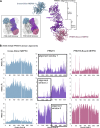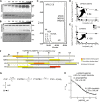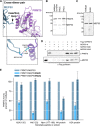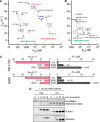Histone H2A and H4 N-terminal tails are positioned by the MEP50 WD repeat protein for efficient methylation by the PRMT5 arginine methyltransferase
- PMID: 25713080
- PMCID: PMC4392268
- DOI: 10.1074/jbc.M115.636894
Histone H2A and H4 N-terminal tails are positioned by the MEP50 WD repeat protein for efficient methylation by the PRMT5 arginine methyltransferase
Abstract
The protein arginine methyltransferase PRMT5 is complexed with the WD repeat protein MEP50 (also known as Wdr77 or androgen coactivator p44) in vertebrates in a tetramer of heterodimers. MEP50 is hypothesized to be required for protein substrate recruitment to the catalytic domain of PRMT5. Here we demonstrate that the cross-dimer MEP50 is paired with its cognate PRMT5 molecule to promote histone methylation. We employed qualitative methylation assays and a novel ultrasensitive continuous assay to measure enzyme kinetics. We demonstrate that neither full-length human PRMT5 nor the Xenopus laevis PRMT5 catalytic domain has appreciable protein methyltransferase activity. We show that histones H4 and H3 bind PRMT5-MEP50 more efficiently compared with histone H2A(1-20) and H4(1-20) peptides. Histone binding is mediated through histone fold interactions as determined by competition experiments and by high density histone peptide array interaction studies. Nucleosomes are not a substrate for PRMT5-MEP50, consistent with the primary mode of interaction via the histone fold of H3-H4, obscured by DNA in the nucleosome. Mutation of a conserved arginine (Arg-42) on the MEP50 insertion loop impaired the PRMT5-MEP50 enzymatic efficiency by increasing its histone substrate Km, comparable with that of Caenorhabditis elegans PRMT5. We show that PRMT5-MEP50 prefers unmethylated substrates, consistent with a distributive model for dimethylation and suggesting discrete biological roles for mono- and dimethylarginine-modified proteins. We propose a model in which MEP50 and PRMT5 simultaneously engage the protein substrate, orienting its targeted arginine to the catalytic site.
Keywords: Enzyme Kinetics; Enzyme Mechanism; Histone Methylation; Peptide Array; Protein Arginine N-methyltransferase 5 (PRMT5); WD Repeat.
© 2015 by The American Society for Biochemistry and Molecular Biology, Inc.
Figures








Similar articles
-
Structure of the arginine methyltransferase PRMT5-MEP50 reveals a mechanism for substrate specificity.PLoS One. 2013;8(2):e57008. doi: 10.1371/journal.pone.0057008. Epub 2013 Feb 25. PLoS One. 2013. PMID: 23451136 Free PMC article.
-
Protein arginine methyltransferase 5 catalyzes substrate dimethylation in a distributive fashion.Biochemistry. 2014 Dec 23;53(50):7884-92. doi: 10.1021/bi501279g. Epub 2014 Dec 8. Biochemistry. 2014. PMID: 25485739
-
Protein arginine methyltransferase Prmt5-Mep50 methylates histones H2A and H4 and the histone chaperone nucleoplasmin in Xenopus laevis eggs.J Biol Chem. 2011 Dec 9;286(49):42221-42231. doi: 10.1074/jbc.M111.303677. Epub 2011 Oct 18. J Biol Chem. 2011. PMID: 22009756 Free PMC article.
-
The PRMT5 arginine methyltransferase: many roles in development, cancer and beyond.Cell Mol Life Sci. 2015 Jun;72(11):2041-59. doi: 10.1007/s00018-015-1847-9. Epub 2015 Feb 7. Cell Mol Life Sci. 2015. PMID: 25662273 Free PMC article. Review.
-
The Structure and Function of the PRMT5:MEP50 Complex.Subcell Biochem. 2017;83:185-194. doi: 10.1007/978-3-319-46503-6_7. Subcell Biochem. 2017. PMID: 28271477 Review.
Cited by
-
Germ-line mutations in WDR77 predispose to familial papillary thyroid cancer.Proc Natl Acad Sci U S A. 2021 Aug 3;118(31):e2026327118. doi: 10.1073/pnas.2026327118. Proc Natl Acad Sci U S A. 2021. PMID: 34326253 Free PMC article.
-
PRMT5 is essential for the maintenance of chondrogenic progenitor cells in the limb bud.Development. 2016 Dec 15;143(24):4608-4619. doi: 10.1242/dev.140715. Epub 2016 Nov 8. Development. 2016. PMID: 27827819 Free PMC article.
-
Class IIa HDAC inhibition reduces breast tumours and metastases through anti-tumour macrophages.Nature. 2017 Mar 16;543(7645):428-432. doi: 10.1038/nature21409. Epub 2017 Mar 8. Nature. 2017. PMID: 28273064 Free PMC article.
-
Chemical biology of protein arginine modifications in epigenetic regulation.Chem Rev. 2015 Jun 10;115(11):5413-61. doi: 10.1021/acs.chemrev.5b00003. Epub 2015 May 13. Chem Rev. 2015. PMID: 25970731 Free PMC article. Review. No abstract available.
-
Novel Chemicals Derived from Tadalafil Exhibit PRMT5 Inhibition and Promising Activities against Breast Cancer.Int J Mol Sci. 2022 Apr 27;23(9):4806. doi: 10.3390/ijms23094806. Int J Mol Sci. 2022. PMID: 35563196 Free PMC article.
References
-
- Wysocka J., Allis C. D., Coonrod S. (2006) Histone arginine methylation and its dynamic regulation. Front. Biosci. 11, 344–355 - PubMed
Publication types
MeSH terms
Substances
Grants and funding
LinkOut - more resources
Full Text Sources
Other Literature Sources

